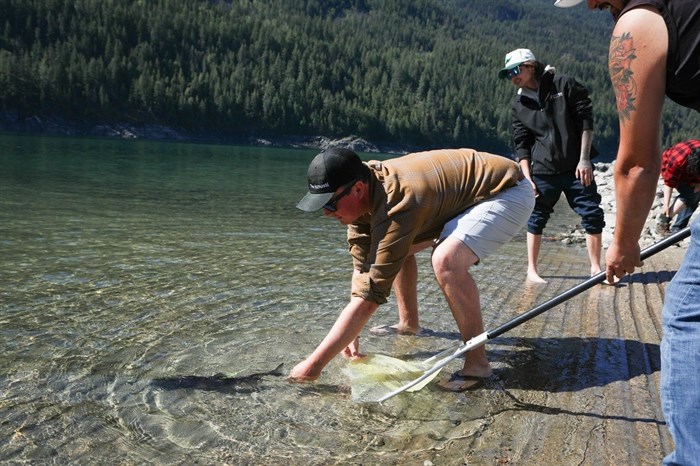
Lance Thomas, with the Ktunaxa Nation’s ?a·knusti (Guardian) program, releases an acoustically tagged adult sockeye salmon into the Arrow Lakes on Aug. 30, 2024.
Image Credit: Aaron Hemens, Local Journalism Initiative
September 06, 2024 - 6:00 PM
Lance Thomas sent well wishes as he helped release dozens of adult sockeye salmon into the Arrow Lakes last week.
“Pray that they have a safe journey,” said Thomas, with the Ktunaxa Nation’s ?a·knusti (Guardian) program.
More than 80 years after the species was blocked from returning to its spawning habitat in the Upper Columbia River system, the Ktunaxa, Secwépemc, and sylix Okanagan nations are bringing sockeye back to the waterway.
Now, the nations’ researchers will closely monitor the species’ movements, in hopes of identifying potential spawning grounds.
So far this summer, the initiative has tagged and released 57 adult sockeye carrying acoustic-tracking beacons into the lakes — 16 of them in July, and 41 last month.
The most recent release on Aug. 30 brought together representatives from sylix Okanagan and Ktunaxa nations, as well as local officials.
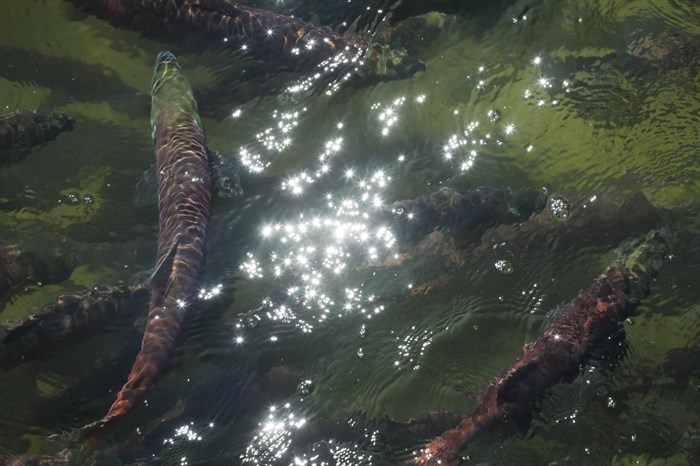
Adult sockeye salmon swim near the dam at Okanagan Falls Provincial Park on Aug. 29, 2024.
Image Credit: Aaron Hemens, Local Journalism Initiative
Biologists with the Bringing the Salmon Home initiative hope following the species’ movements — as sockeye seek spawning locations in waters they haven’t swum since 1938 — will help to bring the fish back to the region.
“The goal is to try and see if they key in on any specific tributary-spawning sites,” said Patrick Zubick, a fisheries biologist with the Okanagan Nation Alliance (ONA), based in the Columbia region — where river blockages have for decades stopped sockeye from migrating from the sea hundreds of kilometres to the west.
Bringing the Salmon Home is part of a long-term plan developed by the syilx Okanagan, Secwépemc, and Ktunaxa nations — and involving provincial and federal governments — to re-introduce salmon into the Upper Columbia River.
Many of the tagged fish came from the Okanagan water system’s population, and are a mix of males and females.
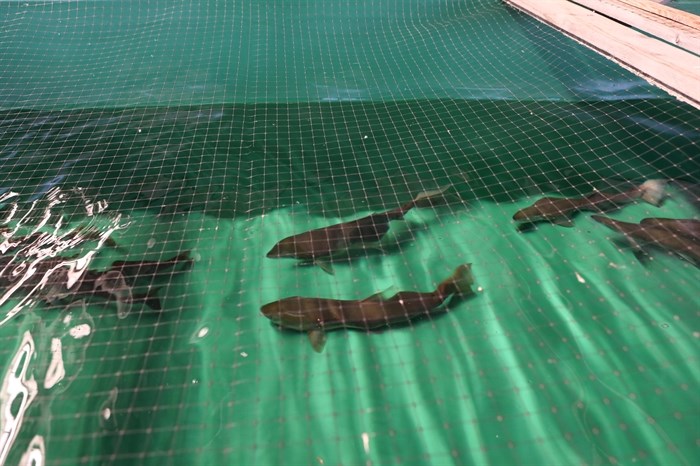
Adult sockeye salmon swim in a tank at the hatchery in Penticton before being acoustically tagged on Aug. 29, 2024.
Image Credit: Aaron Hemens, Local Journalism Initiative
At the hatchery in Penticton, researchers attached thin green cords — known as “spaghetti” tags — to the salmon before releasing them into the wild. Small black acoustic tags were also inserted into their stomachs.
It's the small black tags that produce a unique electronic “ping” when the fish swims near one of the acoustic receivers in the lake.
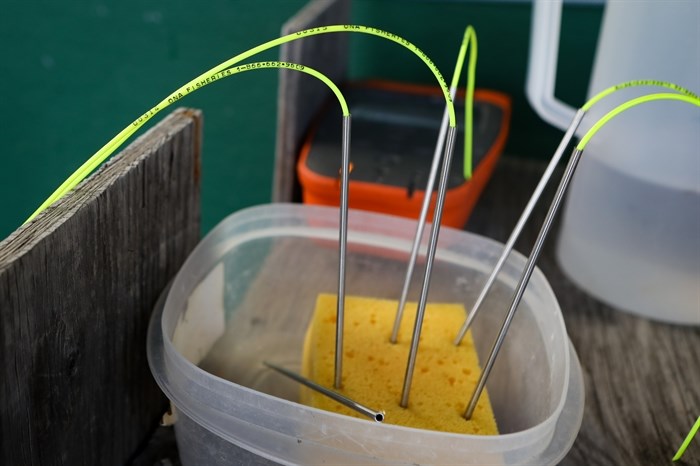
Researchers attached thin green cords — known as “spaghetti” tags — to the salmon before releasing them into the wild.
Image Credit: Aaron Hemens, Local Journalism Initiative
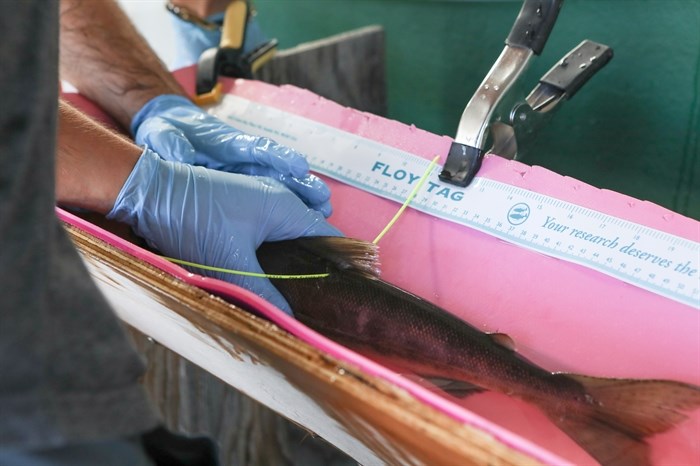
A sockeye salmon is fitted with a green acoustic-monitoring cord, known as a ‘spaghetti’ tag.
Image Credit: Aaron Hemens, Local Journalism Initiative
Researchers placed 27 such acoustic receivers throughout the 232-kilometre-long Arrow Lakes reservoir, from the waterway’s south end near Castlegar north to Revelstoke.
When one of the receivers detects a signal from a fish tag, biologists can identify the individual salmon, including characteristics such as its length, sex, and location at that moment.
“Thirty fish were hanging at (a creek) for seven days right before spawning is supposed to start,” Zubick said. “They clearly like that location.
“Let’s dig into why — through that, it’ll inform future work, if we deem re-introduction feasible.”
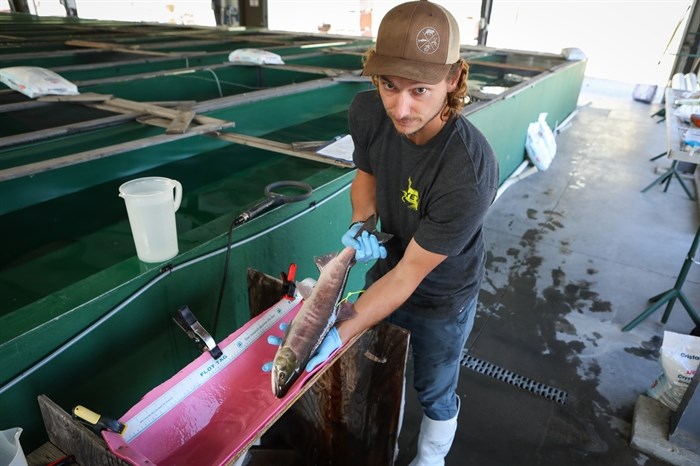
ONA fisheries biologist Patrick Zubick holds an adult sockeye salmon, after fitting it with an acoustic monitoring tag at the hatchery in Penticton on Aug. 29, 2024.
Image Credit: Aaron Hemens, Local Journalism Initiative
Biologists chose to install some of their acoustic receivers where they suspect salmon may travel to spawn, especially near tributary creeks and streams.
Those ecosystems are already home to large numbers of kokanee salmon — a landlocked species that, unlike its close sockeye relatives, only ever lives in freshwater.
“If they are going to choose a spawning location, that’s where they would choose,” Zubick explained. “If (juveniles) are able to make it to the ocean and subsequently back as adults, then they would go back to these locations.”
Once the released sockeye choose their spawning grounds, the team will then “evaluate the survival of those juveniles in that location,” he added.
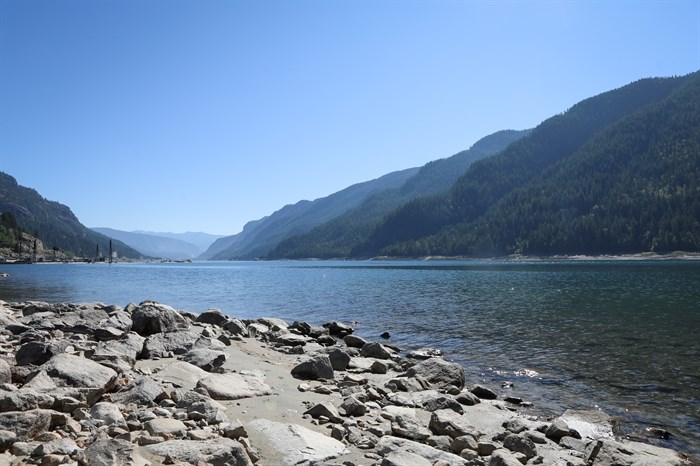
The Arrow Lakes, part of the Upper Columbia River system, are pictured on Aug. 30, 2024.
Image Credit: Aaron Hemens, Local Journalism Initiative
A broader goal is to also help the salmon reproduce naturally in the wild, something Zubick described as a “dual purpose” of the study.
“Follow them to where they want to be, and it can help inform us on our work,” he explained. “If they are successful in reproducing, they can seed the habitat a little bit, too.”
The construction of Washington state’s 168-metre-high Grand Coulee Dam in the 1930s — today by far the largest power station in the U.S., generating 6,800 megawatts of electricity — harmed the river’s salmon populations, Zubick said, leaving them unable to return to the Upper Columbia River region.
“It’s obviously a much-changed system since it was back then, with the other dams that have been added,” he said. So today’s efforts to reverse the damage to historic sockeye migration routes are “a long time coming.”
“It’s a re-connection with the land,” he said of the initiative, “with the animal that’s been missing for a while.”

The Arrow Lakes, part of the Upper Columbia River system, are pictured on Aug. 30, 2024.
Image Credit: Aaron Hemens, Local Journalism Initiative
‘Given the slimmest of chances, the salmon will come back’
With this year’s spawning season expected in October, the adult fish are at the end of their life cycle. Preliminary data shows most of the fish have survived, Zubick said, adding that researchers will take a closer look later in the fall at how many of the released salmon survived and reproduced.
“Can they do it? If adults come back, are they going to find a location to spawn?” said Zubick. “If they can, hopefully all the data and information we collect will inform a re-introduction program at some point — if it’s deemed feasible.”
Alfred Snow, a fishery technician with the ONA, said he is optimistic the fish will reunite and find a suitable place to spawn.
“I hope those guys are still around,” Snow said. “I hope it all goes well.”

A member of the Ktunaxa Nation prepares to release an acoustically tagged adult sockeye salmon into the Arrow Lakes on Aug. 30, 2024.
Image Credit: Aaron Hemens, Local Journalism Initiative
Michael Zimmer, fisheries team lead for ONA’s Columbia region, said this is only the first year of their adult sockeye movement study. In the future, he said, researchers hope to expand the study to include chinook salmon, too.
Previous studies of released young salmon, known as fry, have proven the juveniles can, indeed, make it to the ocean, he said. Most importantly, the salmon have also been able to return up-river — reaching inland as far as “Washington” state’s Wells Dam, some 80 kilometres downriver from the massive Grand Coulee Dam.
“That’s nine dams up” the Columbia River, Zimmer said. “Given the slimmest of chances, the salmon will come back.”
With the current data available, and Indigenous communities’ dreams of bringing their salmon home, Zimmer said now is the time to act.
“Let’s all work together to make this happen,” he said.
— This story was originally published by IndigiNews.
News from © iNFOnews, 2024